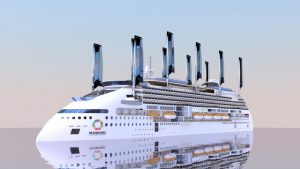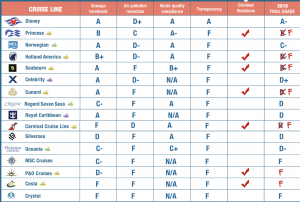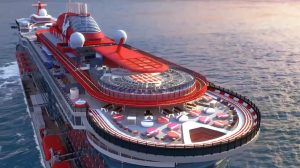Environmental impact of cruising
The world of cruises is constantly growing. Let’s see how to protect the environment in this Cruising Journal‘s analysis.
Cruising is growing in popularity. More than 26 million people took a cruise in 2018, and market projections have that number set to grow. Cruise ship catalogues often describe the ships as floating cities and, like cities, cruise ships also have a problem with pollution. Despite the ocean breezes, German watchdog NABU ((Nature and Biodiversity Conservation Union) found that the air on the deck of a cruise ship is more similar to the air in one of the world’s most polluted cities than to paradise.
According to Pacific Standard magazine, cruising triples each passengers’ carbon footprint for the duration of the cruise. In addition to using the dirtiest of all fuels and pumping out toxic exhaust fumes, cruise ships have a history of dumping trash, fuel and sewage directly into the ocean.
A 2017 investigation by the United Kingdom’s Channel Four television station found that a single cruise ship can emit as much particulate matter into the air in a single day as one million cars.To prevent ships from burning fuel in dock, ports in Los Angeles, Long Beach, San Francisco and San Diego have begun powering docked ships with electricity, cutting pollution from the ships at berth by 95 percent.
While the cruise industry has been urged to switch to cleaner fuels such as liquefied natural gas, or even to go electric, few lines have headed the call. New international legislation coming into force in 2020 will require ships to reduce their sulphur emissions to a maximum of 0.5 percent. Most cruise lines are using scrubbers to remove the pollutants from the ship’s exhaust and bring their sulphur emissions down. However, many ships then dump the collected pollutants directly into the sea.
While you can’t do anything about the ship’s sulphur emissions, you can help to minimise your carbon footprint while on the cruise. So, what can passengers do to encourage the greening of the cruise industry?
Take an eco-cruise
Perhaps the most effective way to improve your cruising carbon footprint is to spend your cruise dollars on a sustainable cruise. There are a limited number of these, but their numbers are growing each year. Cruise line Hurtigruten uses hybrid ships, which are powered by a battery system. Norwegian ferry line Color Line also has plans for a battery powered plug-in hybrid ferry. Finish cruise company Viking Line is exploring wind power, and has partnered with energy company Norsepower to install a rotor sail system on an LNG-powered ship, helping to cut emissions. There’s even a zero-waste Japanese ‘Ecoship’, dubbed the Peace Boat, in the works. The ship would use a hybrid engine, combined with wind and solar power.

But cruise lines are not always forthcoming about their lack of green credentials, which can make it difficult to choose the most eco-friendly cruise. To help, environmental organisation Friends of the Earth (FoE) releases a yearly cruise ship report card. Until recently, the major cruise lines and the Cruise Line International Association cooperated with FoE in sharing data. However, the lines stopped cooperating in 2016 over a disagreement about how FoE analysed its data. Today, Disney is the only line still cooperating with FoE.

The score card grades each cruise line and ship from A–F, based on how they deal with sewage, air pollution and water quality, as well as their level of transparency. The big cruise lines also all have an environment and sustainability section on their websites where you can find out what they are doing to reduce their impact.
Choose a smaller ship
As an alternative to the big, luxurious cruise experience, think about choosing a smaller ship, with a smaller environmental footprint. A number of small cruise lines aim to put
protecting the marine environment at the core of what they do. In Svalbard, cruise companies follow guidelines laid down by the Association of Arctic Expedition Cruise Operators (AECO). To find an ecologically sound boat trip in the Galapagos, check out the Smart Voyager certification, created in partnership with the Rainforest Alliance.
Reduce waste
Most people now recycle at home, and there is no reason not to continue this shipboard. Most ships have recycling bins, and some even have composting bins. In addition to doing away with buffets and tips, Virgin Voyages, which launches in 2020, plans to ban single use plastics on board. MSC has already removed most single-use plastics, and many cruise lines have removed most plastic straws.

You can also help by bringing a refillable water bottle so you don’t need to use disposable plastic bottles, avoid using plastic straws and bringing a reusable shopping bag for on-shore shopping. Some people take this a step further by bringing their own metal straws and reusable coffee cups.
Reduce consumption
Just as at home, you can reduce your consumption on board. Turn the lights off in your cabin when you go out, and unplug your electrics once they are fully charged. Open a window to cool off instead of using the air conditioning. You can also reuse your bed linens and towels, so they aren’t washed as frequently, and take shorter showers.
Some ships compost their food waste, but others dump it on shore or in the ocean, so if there is a buffet, consider putting less food on your plate and refilling more often instead to avoid throwing out uneaten food. You can also avoid pre-packaged foods – the paper from individually-wrapped cereal packets and pats of butter adds up to a lot of waste.

You can also help conserve when packing by choosing eco-friendly shampoos, sunscreens and cosmetics that are free of microbeads.
Ask questions
The best way to find out the environmental credentials of a cruise line is to check with the line itself. Most cruises now also have an environmental officer who can guide you. For example, some ships bottle drinking water on board, making it just as environmentally friendly to drink the bottled water, as to refill a reusable bottle from home using the tap in your room. And, the more people ask, the more cruise lines will take these things seriously. The cruise industry is highly competitive. So, companies that get pressure from customers to improve their sustainability and environmental standards are likely to listen.
